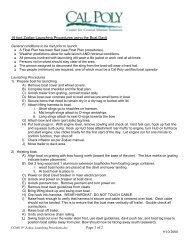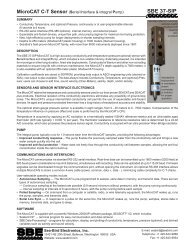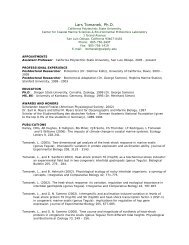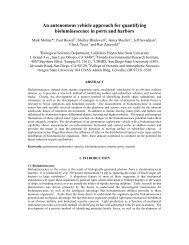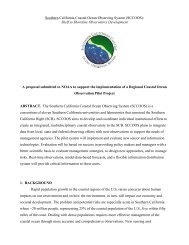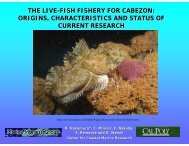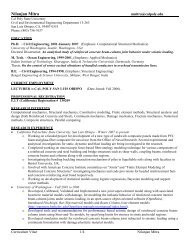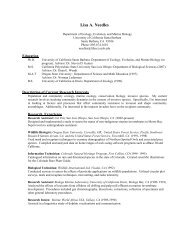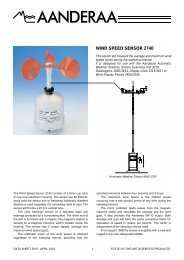Johanna Weston - Cal Poly Center for Coastal Marine Sciences
Johanna Weston - Cal Poly Center for Coastal Marine Sciences
Johanna Weston - Cal Poly Center for Coastal Marine Sciences
Create successful ePaper yourself
Turn your PDF publications into a flip-book with our unique Google optimized e-Paper software.
Evaluation of the Benewah<br />
Creek Restoration Project<br />
<strong>Johanna</strong> <strong>Weston</strong><br />
University of Dallas<br />
Dr. Chris Peery<br />
University of Idaho<br />
Dr. Dale Chess<br />
Angelo Vitale<br />
Coeur d’Alene Tribe Fisheries Program
Benewah Creek Restoration<br />
Evaluation<br />
‣ Benewah Creek Long-term<br />
Goals<br />
‣ Summer 2007 Monitoring Project<br />
• Stream Temperature Patterns<br />
• Macroinvertebrate Communities<br />
• Trout Populations<br />
• Snorkeling<br />
• Electroshocking<br />
‣ Conclusions
Coeur d'Alene Indian Reservation<br />
µ<br />
0 10<br />
Miles<br />
Plummer<br />
Benewah Creek<br />
US HWY 95<br />
£¤<br />
Moscow<br />
STATE HWY 8<br />
¬«<br />
http://inside.uidaho.edu<br />
http://seamless.usgs.gov
Benewah Creek<br />
‣ Splash Dam, Logging, and<br />
Grazing<br />
‣ Physical stream degradation<br />
‣ Non-native native brook trout (S.(<br />
fontinalis)<br />
‣ Coeur D’Alene D<br />
Tribe Fisheries<br />
Program<br />
‣ 3.2 miles of stream restoration<br />
Overall Goal: : Holistic revival<br />
westslope cutthroat trout (O. clarki lewisi)
Other Monitoring Methods<br />
‣ Habitat quality and physical changes<br />
measurements<br />
‣ Temperature patterns<br />
‣ O. clarki lewisi population assessments
Summer 2007 Project Goals<br />
‣ University of Idaho - NSF REU<br />
‣ Evaluate biological response of restoration<br />
ef<strong>for</strong>ts<br />
• Stream temperature patterns<br />
• Macroinvertebrate communities<br />
• Fish density and trout populations<br />
‣ Provide baseline data <strong>for</strong> index sites<br />
‣ Present methods <strong>for</strong> monitoring
Specific Study Sites<br />
‣ Completed restoration sections <strong>for</strong> 2005 and 2006<br />
‣ Started restoration section <strong>for</strong> 2007<br />
‣ Monitoring Sites 2007<br />
• Restored 2005<br />
• Restored 2006<br />
• Un-restored 2007<br />
• Highly Disturbed Reference - Meadow<br />
• Minimally Disturbed Reference - Pristine
Benewah Creek Restoration<br />
Evaluation<br />
‣ Benewah Creek Long-term Goals<br />
‣ Summer 2007 Monitoring Project<br />
• Stream Temperature Patterns<br />
• Macroinvertebrate Communities<br />
• Trout Populations<br />
• Snorkeling<br />
• Electroshocking<br />
‣ Conclusions
Stream Temperature<br />
‣ Temporal temperature patterns<br />
• Five Hobo Temperature Sensors<br />
• Air temperature<br />
• Every hour from 18 June to 20 July 2007<br />
‣ Spatial temperature patterns<br />
• Temperature probe<br />
• 19 June 2007
Temporal Steam Temperature<br />
Pattern<br />
30.00<br />
25.00<br />
20.00<br />
15.00<br />
R2005<br />
R2006<br />
Meadow<br />
Site 17<br />
Pristine<br />
10.00<br />
5.00<br />
0.00<br />
Date and Time
Temporal Air Temperature<br />
Pattern<br />
40.00<br />
35.00<br />
30.00<br />
25.00<br />
20.00<br />
15.00<br />
10.00<br />
5.00<br />
0.00<br />
-5.00<br />
Time and Date
Spatial Temperature Pattern<br />
Nine Mile Bridge<br />
!<br />
!<br />
Benewah Road<br />
Whitetail Creek<br />
! !!<br />
! ! !!<br />
!<br />
!<br />
! !<br />
! !! !<br />
! !<br />
!!<br />
!! !!! !!<br />
! !<br />
!<br />
!<br />
!<br />
!<br />
! !<br />
B e n e w a h C r e e k<br />
Temperature (oC) from 19 June 2007<br />
Temp<br />
! 0.0<br />
9.9<br />
10.0 - 10.5<br />
10.6 - 10.9<br />
11.0 - 11.1<br />
11.2 - 11.4<br />
11.5 - 11.7<br />
11.8 - 11.9<br />
12.0 - 12.2<br />
12.6 - 13.0<br />
14.0 - 14.2<br />
14.3 - 14.5<br />
14.6 - 14.7<br />
14.8 - 15.0<br />
15.1 - 15.3<br />
15.4 - 15.6
Stream Temperature Results<br />
‣ Same stream = same temperature patterns<br />
‣ Diurnal Cycle: 5 – 10 o C variation<br />
‣ Substantial variation moving downstream<br />
- More than just air temperature<br />
- Differences in riparian cover<br />
- Water depth, flow levels, and groundwater<br />
interaction
Benewah Creek Restoration<br />
Evaluation<br />
‣ Benewah Creek Long-term Goals<br />
‣ Summer 2007 Monitoring Project<br />
• Stream Temperature Patterns<br />
• Macroinvertebrate Communities<br />
• Fish and Trout Populations<br />
• Snorkeling<br />
• Electroshocking<br />
‣ Conclusions
Macroinvertebrates<br />
‣ 20 samples from 5 different stream<br />
reaches<br />
• Two pools and two riffles<br />
• Restored 2005, Restored 2006, Unrestored<br />
2007, Meadow, Pristine<br />
‣ 3-minute kicks with a d-netd<br />
‣ Samples sorted and identified to family
Abundance of Macroinvertebrates<br />
350<br />
300<br />
250<br />
200<br />
150<br />
100<br />
50<br />
0<br />
Restored 2005<br />
Unrestored 2007<br />
Pristine<br />
Restored 2006<br />
Meadow<br />
0 1 2 3 4 5 6<br />
Stream Section (Downstream to Upsteam)
Richness of Macroinvertebrates<br />
30<br />
25<br />
20<br />
15<br />
10<br />
5<br />
0<br />
R2005 R2006 UR2007 Meadow Pristine<br />
Stream Section (downstream to upstream)
Macroinvertebrates Diversity and<br />
Evenness<br />
2.500<br />
2.000<br />
1.500<br />
Shannon<br />
Diversity<br />
Evenness<br />
1.000<br />
0.500<br />
0.000<br />
R2005 R2006 UR2007 Meadow Pristine<br />
Section (downstream to upstream)
Macroinvertebrates Results<br />
‣ Pristine section has the greatest abundance,<br />
richness, and diversity values<br />
‣ Restored and degraded sections have lower and<br />
similar values<br />
‣ Upstream restoration<br />
impacts downstream<br />
communities
Benewah Creek Restoration<br />
Evaluation<br />
‣ Benewah Creek Long-term Goals<br />
‣ Summer 2007 Monitoring Project<br />
• Stream Temperature Patterns<br />
• Macroinvertebrate Communities<br />
• Trout Populations<br />
• Snorkeling<br />
• Electroshocking<br />
‣ Conclusions
Fish: Snorkeling<br />
‣ R-2005, R-2006, R<br />
Meadow, and Pristine<br />
reaches<br />
‣ Overlaps with macroinvertebrate sampling<br />
‣ Estimates population size and interaction<br />
‣ Counting and identification of all fish seen
Snorkeling Density and Population<br />
Section R2005 R2006 Meadow Pristine<br />
Area 555.3 m 2 743.6 m 2 177.1 m 2 226.1 m 2<br />
Count Density Count Density Count Density Count Density<br />
Cutthroat Trout 0 0 0.0 0 4 0.02 27 0.12<br />
Brook Trout 0 0 0.0 0 4 0.02 0 0.00<br />
Non-salmonid 332 0.71 550.0 0.74 92 0.51 10 0.04<br />
Total 332 0.71 550.0 0.74 100 0.55 37 0.16<br />
% Density of<br />
Salmonids *** 0 0 7.3 75<br />
% Density of Cutthroat 0 0 3.6 75<br />
% Density of Non Trout 100 100 92.7 25
Fish: Electroshocking<br />
‣ Three pass electroshocking<br />
‣ All surfaced fish collected and counted<br />
‣ WCT and BT were weighed and<br />
measured<br />
‣ Brook trout were<br />
exterminated
Electroshocking Density and Population<br />
R-2005 R-2006 Meadow Pristine<br />
Area 555.3 m 2 743.6 m 2 177.1 m 2 226.1 m 2<br />
Fish Count Density Count Density Count Density Count Density<br />
Sculpin 13 0.023 1 0.001 11 0.062 19 0.084<br />
Longscale Sucker 0 0 3 0.004 0 0 0 0.000<br />
Red Sided Shiner 55 0.099 9 0.012 92 0.519 2 0.009<br />
Longnose Dace 1 0.002 1 0.001 11 0.062 1 0.004<br />
Brook Trout 1 0.002 3 0.004 18 0.102 23 0.102<br />
Cutthroat Trout 0 0 0 0.000 0 0 9 0.040<br />
Total 70 0.126 17 0.022 132 0.745 54 0.239<br />
% Density of<br />
Salmonids *** 1.6 18.2 14.9 59.4<br />
% Density of<br />
Cutthroat 0.0 0.0 0.0 16.7<br />
% Density of Non Trout 98.4 81.8 85.1 23.9
Fish Results<br />
‣ Pristine significantly showed highest<br />
percent density of salmonids<br />
• Cutthroats only seen in the pristine section<br />
• Increased trout density in the pristine<br />
‣ Snorkeling and electroshocking give<br />
similar trends
Benewah Creek Restoration<br />
Evaluation<br />
‣ Benewah Creek Long-term Goals<br />
‣ Summer 2007 Monitoring Project<br />
• Stream Temperature Patterns<br />
• Macroinvertebrate Communities<br />
• Trout Populations<br />
• Snorkeling<br />
• Electroshocking<br />
‣ Conclusions
Conclusions<br />
‣ Restoration affects stream temperature<br />
‣ Pristine trended to higher abundance,<br />
richness, and diversity of<br />
macroinvertebrate communities<br />
‣ Restoration limiting trout habitat<br />
• Pristine contains physical and biological<br />
factors to provide cutthroat trout habitat
Discussion<br />
‣ Trends in stream condition post-restoration not<br />
as strong as expected<br />
‣ Pristine sections still best <strong>for</strong> WCT recovery<br />
‣ Restored sections experience lasting restoration<br />
disturbances<br />
‣ Restoration that has a shorter recovery time a<br />
better option than no intervention
Recommendations<br />
‣ Analyze habitat qualities<br />
‣ Measure flow, stream depth,<br />
and groundwater interaction<br />
‣ Larger sample sizes<br />
‣ Seasonal changes in macroinvertebrate and fish<br />
communities<br />
‣ Fish growth and spawning locations
Evaluation of the Benewah Creek<br />
Restoration Project<br />
Dr. Chris Peery<br />
Coeur d’Alene d<br />
Tribe<br />
Fisheries Program<br />
Kal Johnson<br />
REU Students<br />
University of Idaho<br />
National Science<br />
Foundation<br />
RRNW <strong>for</strong> this opportunity



